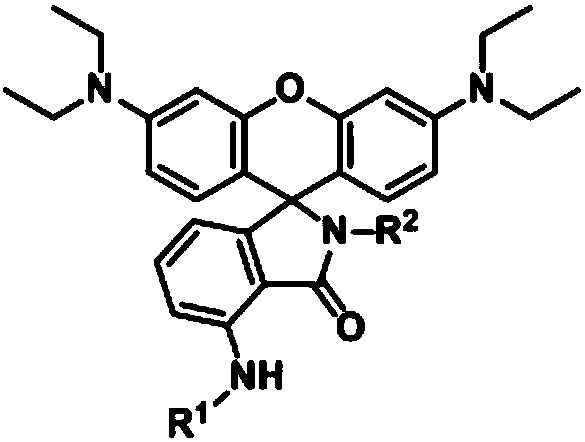Acid-resistant photo-controlled fluorescent molecular switch in organic solution, and synthesis method thereof
A technology of organic solutions and fluorescent molecules, applied in the fields of organic chemistry, fluorescence/phosphorescence, chemical instruments and methods, etc., can solve the problems of interference with the authenticity of fluorescent signals and the failure of photoactivation performance of dyes, so as to reduce background fluorescence interference and avoid fluorescence The effect of background distraction
- Summary
- Abstract
- Description
- Claims
- Application Information
AI Technical Summary
Problems solved by technology
Method used
Image
Examples
Embodiment 1
[0031] Molecule (P1) synthetic route and product structure are as follows:
[0032]
[0033] Synthesis steps and characterization: 3-Nitrorhodamine (5mmol, 2.4g) and n-butylamine (20mmol, 1.4g) were dissolved in absolute ethanol (50mL). The temperature was raised to 78°C for reflux, and after stirring for 8 hours, the solvent was evaporated under reduced pressure, and the product was separated and purified by silica gel chromatography (petroleum ether / ethyl acetate, 8:1v / v), and the obtained light yellow powder (2.6g, 95% ). Then all the powder was dissolved in methanol / dichloromethane (50mL, 3:1v / v) mixed solvent, under hydrogen atmosphere, by palladium carbon (0.21g, 10%wt) catalytic reduction, the filtrate was taken by suction filtration, and the The final product (2 g, 98%) was obtained as a white powder after removal of the solvent by autoclaving.
[0034] The product was characterized by NMR and mass spectrometry: 1 H NMR (400MHz, CDCl 3 )δ7.14(t, J=7.6Hz, 1H), 6....
Embodiment 2
[0038] Molecular (P2) synthetic route and product structure are as follows:
[0039]
[0040] Synthesis steps and characterization: P1 (0.25g, 0.5mmol), iodomethane (0.28g, 2mmol) and potassium carbonate (0.34g, 2.5mmol) were mixed in acetonitrile (8mL), stirred at reflux for 10 hours, cooled to room temperature and filtered The filtrate was obtained, and the solvent was evaporated under reduced pressure. The crude product was separated and purified by column chromatography (silica gel, petroleum ether / ethyl acetate, 10:1 v / v) to obtain white powder P2 (0.17 g, 65%).
[0041] The product was characterized by NMR and mass spectrometry: 1 H NMR (400MHz, CDCl 3 )δ7.23(t, J=7.9Hz, 1H), 6.75(d, J=4.9Hz, 1H), 6.57(t, J=9.3Hz, 2H), 6.49(d, J=8.1Hz, 1H) ,6.41–6.22(m,5H),3.33(q,J=7.0Hz,8H),3.04(s,2H),2.97(d,J=4.9Hz,3H),1.16(t,J=6.9Hz, 12H), 1.07(s, 4H), 0.67(t, J=6.5Hz, 3H). 13 C NMR (101MHz, CDCl 3 )δ 170.15, 154.93, 153.09, 148.60, 147.23, 133.78, 129.01, 113.08, 110.19, 108....
Embodiment 3
[0045] Molecular (P3) synthetic route and product structure are as follows:
[0046]
[0047] Synthesis steps and characterization: P1 (0.25g, 0.5mmol) and acetyl chloride (58mg, 0.75mmol) were mixed in dichloromethane (5mL), stirred for 2 hours, and the solvent was evaporated under reduced pressure, and the crude product was passed through column chromatography (silica gel, Petroleum ether / ethyl acetate, 8:1 v / v) was separated and purified to obtain white powder P3 (0.26 g, 95%).
[0048] The product was characterized by NMR and mass spectrometry: 1 H NMR (400MHz, CDCl 3 )δ10.60(s,1H),8.43(d,J=8.2Hz,1H),7.39(t,J=7.9Hz,1H),6.74(d,J=7.6Hz,1H),6.46(d, J=8.8Hz, 2H), 6.38(d, J=2.6Hz, 2H), 6.28(dd, J=8.9, 2.6Hz, 2H), 3.34(q, J=7.0Hz, 8H), 3.06(t, J=7.0Hz, 2H), 2.29(s, 3H), 1.17(t, J=7.0Hz, 12H), 1.12–1.02(m, 4H), 0.69(t, J=6.7Hz, 3H). 13 CNMR (101MHz, CDCl 3 )δ169.30,168.85,158.27,153.50,153.27,148.83,136.75,133.81,128.78,117.95,117.52,116.43,108.07,105.32,101.26,99.97,97.7...
PUM
 Login to view more
Login to view more Abstract
Description
Claims
Application Information
 Login to view more
Login to view more - R&D Engineer
- R&D Manager
- IP Professional
- Industry Leading Data Capabilities
- Powerful AI technology
- Patent DNA Extraction
Browse by: Latest US Patents, China's latest patents, Technical Efficacy Thesaurus, Application Domain, Technology Topic.
© 2024 PatSnap. All rights reserved.Legal|Privacy policy|Modern Slavery Act Transparency Statement|Sitemap



